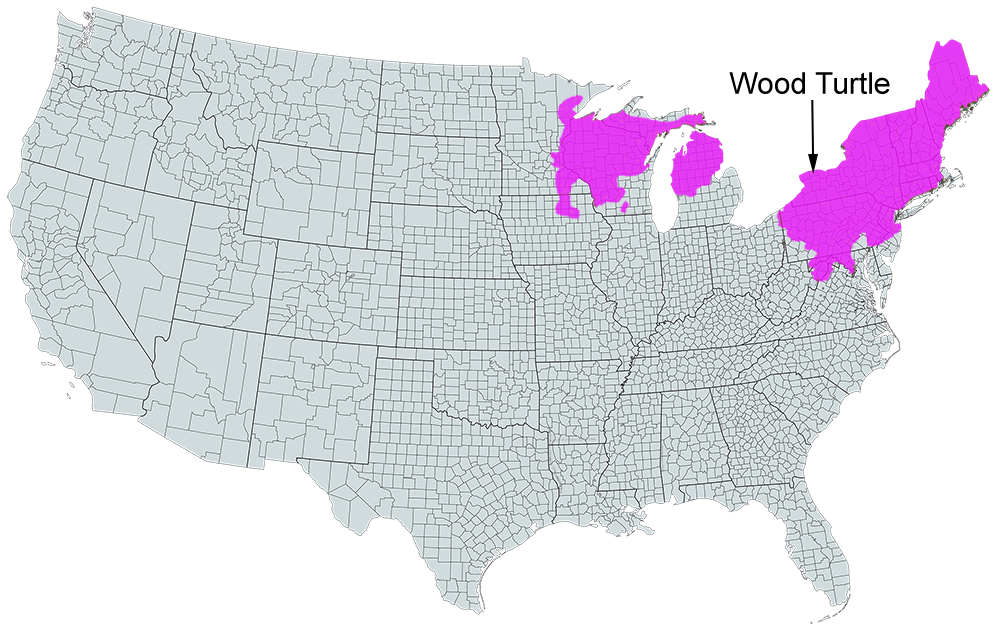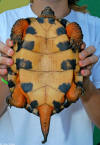Wood Turtle
Glyptemys insculpta
Common Name: |
Wood Turtle |
Scientific Name: |
Glyptemys insculpta |
Etymology: |
|
Genus: |
Giypt is Greek meaning "carved", emys is Greek meaning "turtle". |
Species: |
insculpta is derived from the Latin word insculptus which means "engraved". This refers to the engraved texture of the carapace. |
Average Length: |
5.5 - 8 in. (14 - 20 cm) |
Virginia Record Length: |
8.5 in. (21.6 cm) |
Record length: |
9.2 in. (23.4 cm) |
Systematics: John LeConte originally described this species as Testudo insculpta in 1829, based on a specimen from "the northern states." The type locality was restricted to the vicinity of New York City by Schmidt (1953). The genus Clemmys was first used for this species by Fitzinger (1835). All authors of Virginia literature have used the current nomenclature. No subspecies are recognized.
Description: A moderate-sized terrestrial and semiaquatic turtle reaching a maximum carapace length (CL) of 234 mm (9.2 inches) (Conant and Collins, 1991). In Virginia, known maximum CL is 216 mm and maximum plastron length (PL) is 191 mm (J. F. McBreen, pers. comm,).
Morphology: Carapace flattened and rough (sculptured); each scute consists of a pyramid of irregular growth layers and annuli (grooves) formed because scutes are not shed annually; posterior margin of carapace serrated and flared; marginals 12/12, pleurals 4/4, and vertebrals 5; hingeless plastron 85-100% of CL.
Coloration and Pattern: Carapace brown, often with short black-and-yellow lines radiating from the upper posterior corners of each pleural scute; ventral sides of marginals, as well as bridge, may have black blotches; hingeless plastron yellow, each plastral scute has an irregular to oblong black blotch on each posteriolateral corner; head, neck, and upper parts of limbs brown to black; limbs with red, orange, or yellow pigment on lower surfaces. The head is broad with a flat dorsum; the upper jaw is notched at the midline.
Sexual Dimorphism: Adult males have a concave plastron, a long tail with the anal opening extending beyond the carapace, and enlarged scales on the anterior part of the forelimbs. Females have flat plastrons, a short tail, and no enlarged scales on the forelimbs. Thirteen males from Fairfax and Frederick counties averaged 199.8 mm CL and 179.3 mm PL, and 13 females averaged 179.8 CL and 180.3 mm PL (J. F. McBreen, pers. comm.). Lovich et al. (1990) reported average CLs of 196 mm for males and 183 mm for females from Virginia, but identical PLs (178 mm). Sexual dimorphism indexes based on CL for these two samples were -0.11 and -0.07, respectively. Sexual differences in precloacal distance are unknown. Head width of one adult male (14.8% of CL) was greater than that of one female (11.2% of CL) from Frederick County. The color of the undersides of the limbs, chin, and neck differs between sexes: pale yellow in females and orange-red in males. This is especially prominent in the mating season.
Juveniles: Hatchling Wood Turtles are gray to brown and lack red or orange pigment on the head and legs. The keelless carapace is nearly round in shape and the tail is about as long as the carapace. Hatchlings from five clutches deposited by Virginia females were 34.7-40.4 mm CL (ave. = 38.0 ± 1.3, n = 59) and 28.2-34.9 mm PL (ave. = 32.0 ± 1.4, n = 59) (J. F. McBreen, pers. comm.). Body size of hatchlings from a captive-laid West Virginia clutch was 36.1-39.3 mm CL (ave. = 37.5 ± 1.7, n = 12) and 29.8-33.0 mm PL (ave. = 31.9 ± 0.9), and body mass was 8.5-10.5 g (ave. = 9.4 ± 0.5) (C. A. Pague, pers. comm.). Average PL of 8 hatchlings from Pennsylvania was 26.6 mm (25.9- 27.1; Lovich et al.,1990).
Confusing Species: Few other Virginia turtles can be confused with the Wood Turtle because of the characteristic sculpturing of its shell. Terrapene carolina has a high-domed shell without sculpturing and a hinged plastron that allows the head and limbs to be completely enclosed by the shell. Chelydra serpentina juveniles have long tails, but a small, cross-shaped plastron.
Geographic Variation: None known for Virginia populations. Harding and Bloomer (1979) reported that the red-orange coloration in wood turtles from the eastern and southeastern portion of its range is replaced by yellow and yellowish orange in the western portion.
Biology: Wood Turtles occupy a wide variety of habitats including forested floodplains and nearby slopes, fields in various stages of succession, wet meadows, and farmland. A primary requirement is the presence of water, usually a creek or stream. Simpson and Simpson (1977) reported Virginia Wood Turtles to be common along trout streams and in the flood plains of creeks that had pawpaw (Asimina triloba) and bladdernut (Staphylea trifolia). In Pennsylvania, more time was spent in a creek than in three dominant habitats: alder, grass-sedge-forb, and cornfield (Kaufmann, 1992). The annual cycle is divided into two phases: an aquatic phase and a terrestrial phase. Wood turtles overwinter on the bottom of creeks or streams, under banks overhanging creeks, or in muskrat burrows (Ernst, 1986a). In Virginia, the terrestrial phase occurs from April through November, but some aquatic movements occur in other months (Ernst and McBreen, 1991a). Other observations and museum records of Virginia wood turtles were in April-June (9), July (1), August (3), October (1), and December (1). Both sexes move extensively in spring and summer, remaining in moist habitats (Ernst and McBreen, 1991a). One Virginia male tagged with a radio transmitter moved 1.0 km in one day from his hibernaculum to his summer home range (Ernst and McBreen, 1991a). Wood turtles are diurnal. When not basking or foraging, turtles spend much of the day concealed in or under vegetation. Their daily activity shifts from afternoon in spring to morning in summer and back again in fall (Ernst and McBreen, 1991a).
These turtles consume a wide variety of prey. In Pennsylvania, Surface (1908) found plants in 76% (e.g., filamentous algae, moss, violets [Viola spp.], blueberries [Vaccinium spp.], blackberries [Rubus spp.], sorrel) and animal parts in 80% (earthworms, insects, dead fish, tadpoles, newborn mice) of the specimens he examined. Little is known of the diet of Virginia wood turtles. Kaufmann (1986) described the foraging behavior of "stomping" for earthworms and other invertebrate prey in a population of wood turtles in Pennsylvania. Bouts consisted of tramping rhythmically several times with one front foot and then the other at a rate of one stomp per second, causing the anterior body to rock side to side. Bouts usually lasted more than 15 minutes and two lasted over 4 hours. Earthworms were the predominate prey enticed by the vibrations to come to the surface. This behavior has yet to be observed in Virginia. The primary predators of Wood Turtles are humans, who collect and remove them from natural habitats, run them over on highways, and cause habitat loss. Raccoons (Procyon lotor) and skunks (Mephitis, Spilogale) are known to eat eggs. Juveniles are prey of raccoons, skunks, opossums (Didelphis virginiana), feral cats and dogs, wading birds, crows (Corvus spp.), Snapping Turtles (Chelydra serpentina), and large fish (Harding and Bloomer, 1979). Adults are sometimes eaten by raccoons.
In Virginia, mating and copulation take place in the water and occur primarily in the fall, although some courtship occurs in spring (Ernst and McBreen, 1991a). Mating of several captives from West Virginia occurred on 29 September, 31 October, and 5 December. During mating, males are aggressive, often using tactics that force reluctant females to cooperate. On 29 September 1982, one captive male literally pounced on a female from his rock as she swam by and grabbed the edge of her carapace with all of his feet. He kept her underwater for nearly 15 minutes during which he never allowed her to breathe. In the last 8 minutes he frequently raised his shell above hers and pulled down hard, causing the shells to pound together and producing an audible sound that could be heard from 10 m away. This did not result in mating as the male lost his balance and the female escaped his grasp (C. A. Pague, pers. comm.). Lovich et al. (1990) reported a minimum PL of 141 mm for adult males and 134 mm for adult females in Pennsylvania and Virginia. Age at maturity is unknown for Virginia populations.
Nesting has been observed in Virginia from 28 May to 4 July, and maximum known clutch size is 17 (J. F. McBreen, pers. comm.). Clutches of 9,13, and 8 eggs were recorded for captive West Virginia females on 11 May, 17 June, and about 20 July, respectively (C. A. Pague, pers. comm.). Eggs from two of these clutches averaged 38.3 ± 1.0 x 25.6 ± 0.6 mm (length 36.6-39.4, width 24.8- 26.8) in size and weighed 13.7 g (n = 17). Eggs from Virginia females were elliptical and smooth, and averaged 36.4 ± 2.8 mm (30.6-49.2, n = 99) in length and 23.7 ± 0.9 mm (23.2-24.0, n = 99) in width (J. F. McBreen, pers. comm.). Incubation times for these eggs were 53-64 days and hatchlings emerged from 30 July to 9 August. In New Jersey, hatchlings emerged in August and September (Harding and Bloomer, 1979).
The population ecology of this species in the southern edge of the range of this species is unknown. Harding and Bloomer (1979) reported a population density of 5 adults per acre (12.3 per hectare) in optimal habitat in New Jersey. Simpson and Simpson (1977) noted that, based on verbal reports, the wood turtle was the third most observed turtle in the Frederick-and-Shenandoah county area. Home ranges of 0.4-2.4 hectares have been estimated for northern populations (Harding and Bloomer, 1979). Low reproductive success is probably characteristic of this turtle since it is a long-lived animal. Wood Turtles can live up to 40 years in wild populations (Lovich et al., 1990).
Remarks: A frequently used name for this species in Frederick County is "skiddlepot," sometimes modified to "skillpot" or "siddlepot" (Simpson and Simpson, 1977). The name "redleg" is not used, although some local people refer to the wood turtle as "the turtle with red legs." The common name "wood turtle" is sometimes used for the box turtle, Terrapene carolina.
Conservation and Management: Virginia populations of this species are listed as threatened under Virginia law. The primary threat is loss of habitat along floodplains and silting of creeks from construction activities. An unknown number are killed on highways and collected (now illegally) for the pet trade each year. More intensive inventories need to be conducted and sites protected (especially small waterways; Ernst and McBreen, 1991a) before this species is largely extirpated east of the Blue Ridge. A thorough population-ecology study is needed to evaluate minimal viable population size, demography, and population dynamics so that realistic conservation and management strategies can be developed. Private land owners should be educated about the plight of this species and encouraged to preserve its habitat (Ernst and McBreen, 1991a).
For additional information see: Biology & Conservation of the Wood Turtle
References for Life History
Photos:
*Click on a thumbnail for a larger version.
Verified County/City Occurrence in Virginia
Clarke
Fairfax
Frederick
Loudoun
Page
Rockingham
Shenandoah
Warren
CITIES
Verified in 8 counties and 0 cities.
U.S. Range











